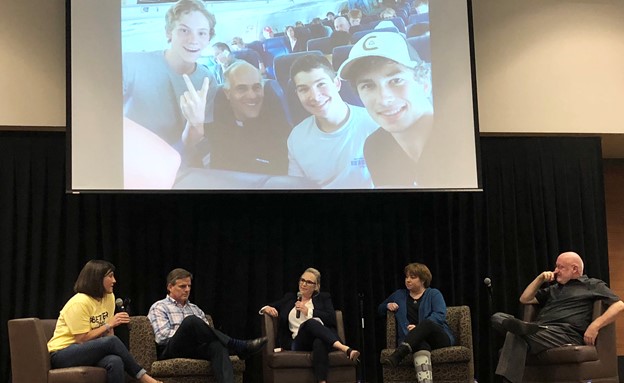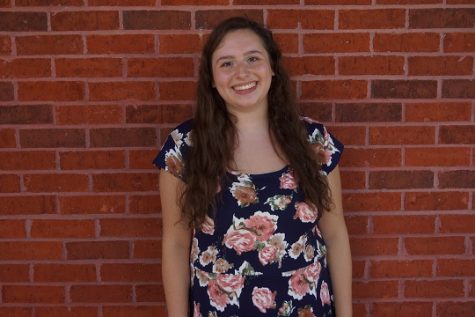Forsyth County’s Suicide Prevention and Mental Health Summit 2018
Left to Right: Lindsay Needham, Gary S. Orris, Krista Wagner, Jennifer Barker, Tom Query; the panel discusses the shock of Logan’s suicide, how his death has changed the lives of others and what the audience members can do to help prevent suicide.
September 20, 2018
What do one teacher, one counselor, two substitute teachers, two parents, one student and one grieving stranger have in common? North Forsyth High School and the Forsyth County Suicide Awareness Meeting. On September 10 at the Forsyth Conference Center, Forsyth County Commissioner Cindy Mills welcomed the audience to an event to raise awareness about mental health and suicide. The conference included vendors, networking and several panels discussing mental health and suicide prevention.
Before the presentation, attendees were able to visit vendor booths and gather information about the subject. Vendors included the Depression and Bipolar Support Alliance (DBSA), AVITA, the National Alliance on Mental Illness (NAMI), Observe Assess Respond for Suicide Prevention (OAR), the Lou Ruspi Jr. Foundation (LRJ), Forsyth County Schools and more. Each table had informative brochures and handouts covering a variety of topics such as mental illnesses and dealing with the loss of someone to suicide.
Walker Tisdale of the Georgia Department of Behavioral Health Developmental Disabilities (DBHDD) was the first speaker of the evening. He began with statistics of suicide. “In 2016, 1,403 Georgians died by suicide, an increase of over 100 people from 2015,” says Walker. He added that firearms are the “most lethal” means of death, leading with “61 percent” (followed by “suffocation,” “poisoning” and “other” means). He then continued to discuss the importance of suicide prevention and how each and every person can help. “We have to start having the conversations about sensitive topics,” he says. He also provided the Georgia Crisis Access Line (800-715-4225) and repeatedly told the audience members to put it in their phones. He analyzed the risk factors and the protective factors for suicide, demonstrating how an environment can affect suicide. Walker concluded by summarizing his main points, pointing out the GCAL number one last time and telling the audience about an upcoming event: the Garrett Lee Smith College Suicide Prevention Conference 2018 on September 24-25 at the Callaway Gardens Resort and Spa Pine Mountain, Georgia.
Next was a powerful, emotional panel about how one teen boy’s suicide affected five different people. Krista Wagner lost her son Logan, a student at West Forsyth High School, to suicide. She shared her experience with Logan: “Most people saw the funny, exuberant boy who was passionate about being a leader… Logan had Tourette syndrome, OCD, ADHD, and pain leading to multiple sinus surgeries.” She continued by listing the differences she noticed in her son’s personality and how he was changing as a person, leading up to his suicide and how she found him. In those few moments, her voice wavered, and the audience began to tremble with tears.
She then transitioned into a discussion with the other four members of the panel, beginning with Lindsay Needham, who is currently a graduation coach at Denmark High School but a former graduation coach at West Forsyth High School (when Logan attended). “I would work with kids that were at risk in some capacity and that’s how Logan was introduced to me,” says Needham; “I knew that he needed a place where he could come and feel safe and not feel judged.”
Following, Wagner asked Gary S. Orris, Logan’s family doctor, how he reacted to Logan’s suicide. Orris responded, “I was shocked … When I had heard that, I didn’t believe it. I thought there must be somebody else. When Logan had left my office the last time I had seen him… he was smiling, he was upbeat and that just reinforces what they may be keeping inside.” She then asked him how a parent should approach the topic when speaking with a family physician. “There should be no hesitation to talk to a physician… There was a side of Logan I obviously didn’t know about, didn’t see. I saw a kid with a great future ahead of him, and he fooled me. I didn’t expect that.”
Then, Wagner spoke with Tom Query, M. Div., LPC, her therapist. “He didn’t know Logan personally but he is helping me through my struggle,” she says. They jump into denying myths and explaining why they are not correct. “One of the biggest ones is that if you ask somebody about suicide… we are going to push them over the edge… That is a myth.” Query then discusses how he handles patients who are talking about suicide in his office. “People who talk about it never will commit suicide. That is another myth. That is not true. In fact, please listen to people. Listen to the subtle things. Listen to the music they are listening to. Find any way you can to listen to your children because they’ll often be talking about it not directly, but in indirect ways.” His third myth was that “Suicide happens without any warning,” to which he responded, “Normally, there [are] a lot of signals.” He continues: “If a person tries it, they’re never going to try it again. That is a myth. In fact, I want you to pay attention, particularly to those kinds of kids and track them.” “‘Someone who wants to end their lives, you are not going to be able to stop it’ is a myth, and there are a lot of people who believe they’re just going to. If they want to kill themselves, they’re going to kill themselves. A myth,” he says. Next, he states, “Suicide is hereditary or somehow biogenetic. It’s a myth, it’s really not true. Particularly in my thirty years of this, I do not see this one to one correlation. I pay attention to it.” Query concludes by discussing common signs of people with suicidal intentions, summarizing these misconceptions and talking about his experience as a therapist with children who have possibly been suicidal.
Lastly, Wagner spoke with another mom on the stage, Jennifer Barker. She shares the story of her daughter, Leah, who attempted suicide multiple times. Barker says she attended “six in-patient treatment facilities.” She continues, “But they put the Band-Aid on the problem. It’s like having a broken leg, and somebody just wants to put a Band-Aid on this because that’ll just make it better.” She explains that the short-term facilities that Leah attended were only a temporary solution. She then describes her experience with one long-term facility where her insurance company would not cover the costs of the services to help her daughter. “I wasn’t worried about her during the day as much because there were people surrounding her. It’s when she came home. It’s when I went to bed at night. Every single night wondering, is she going to be awake? Is she going to be able to wake up when I wake up the next morning? It was nights on the floor watching her sleep,” she says. She then tells the audience of Leah’s last suicide attempt, leaving everyone speechless and emotional. This catalyzed her creation of a GoFundMe page — “… and that GoFundMe page was one of the hardest things I have ever put together because it put everything of her life, every single piece of it, out for the entire world to see.” The page found its way to Wagner and her husband soon after they had lost Logan. “It was through Logan’s death that Leah was able to live,” she says. At the end of the discussion, Wagner surprised the audience by bringing Leah onstage to introduce her and talk about her current status as a college student at the University of North Georgia (UNG) and how she is continuing to help others who are struggling like she did.
Teressa Stan, Executive Director and Cofounder of the LRJ Foundation, began the next presentation about establishing a positive environment in schools. The foundation has started implementing their program of raising awareness of mental health and suicide prevention in Forsyth County, starting with Denmark High School. She shares the story of her brother’s suicide and how that led to the formation of the LRJ’s “Wellness Matters Program.” She then showed a breakdown of the information that the program includes and how the presenters are able to answer questions and counsel students. Joseph, a senior at West Forsyth High School, then came up on stage to discuss the Condition Awareness Club at WFHS, which Logan had been a part of. The session concluded with a video of Joseph discussing how the LRJ Foundation and Logan’s death have united his school and Condition Awareness Club.
After Stann’s presentation, Katie Newman of the Forsyth County School System discussed the actions and programs surrounding mental health that the county is initiating this year. She shared statistics and reasons for suicide, and followed with an analysis of how to help. Next, she broke down the various aspects of the Social and Emotional Learning programs in the county and summarized mental health services and the obstacles they have encountered. “We also offer additional staff trainings… we are rolling out more and more information about how to help teachers support their students without that fear and without that stigma,” says Newman. She then covered how reaching out to the community helps with wellness.
Following Newman’s presentation was Bryan Davidson and Luke Bullard to discuss the Whisper Movement. Davidson summarized what the movement is and described its goal of recognizing everyone and making each person feel wanted. After watching two videos with additional information and students’ experiences, Davidson introduced Bullard, a senior at Lambert High School, who shared his experience with bullying and discovering Whisper. “But I know there are people out there who need to connect with other people,” says Bullard.
Cindy Mills concludes the evening by saying thank you to everyone who attended and including a few reminders about upcoming events.Overall, the summit was very emotional, with powerful discussions that united everyone in the room with love and a desire to fight against suicide.
If you would like to view a recording of the summit, click here.




